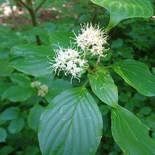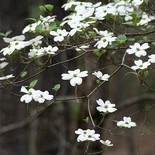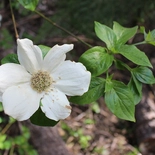There are three species of native dogwood trees found in the United States and southern Canada, all of which have outstanding value for landscaping, as well as for birds and wildlife.

Alternateleaf Dogwood(Cornus alternifolia)

Flowering Dogwood(Cornus florida)

Pacific Dogwood(Cornus nuttallii)
The pagoda or alternate-leaved dogwood (Cornus alternifolia) is found throughout much of the eastern half of North America, from Newfoundland to northern Florida. The flowering dogwood (Cornus Florida) has a somewhat more southerly range, from Maine and Ontario to northeastern Mexico. Western North America has its own species, the Pacific or mountain dogwood (Cornus nuttallii), found contiguously from British Columbia to central California, with a disjunct population, separated by mountains, in Idaho. (In addition to these trees, there are many species of dogwood shrubs.)
Value for Birds
Dogwood berries ripen from summer to fall, depending on the species, and are a magnet for birds. High in fat, the berries are especially valuable for migrating birds, which need to build up the subcutaneous fats required to fuel their rigorous journeys south each fall. Flowering dogwood berries, for example, have twenty-four percent fat content – significantly higher than some other fall fruits such as hawthorn berries which have only six percent fat.
Among the forty-three species of birds that have been documented feeding on dogwood berries, in a study published in 1951 (Martin et al, American Wildlife &Plants), the evening grosbeak was the champion, depending on the berries for twenty-five to fifty percent of its diet. Other species enjoying the berries included wood ducks, grouse, turkeys, and many songbirds.
The dogwood trees are also useful as shelter and nesting sites for birds throughout the growing season.
Value for Other Wildlife
Dogwoods are a host plant for caterpillars of the beautiful little blue butterfly, the spring azure, which is found from Alaska east across Canada and throughout the U.S. to the mountains of Mexico and Panama. The berries are eaten by many mammals, ranging from moose to rabbits.
Landscaping Notes
The flowering dogwood is outstanding in its beauty, “the tree that elevates the clan to horticultural aristocracy,” as author William Cullina writes. The Pacific dogwood is the west coast version of the flowering dogwood, and is equally showy. Both have large white bracts surrounding a bouquet of the minute flowers, which suggest one big blossom. The flowering dogwood has four such bracts, while the Pacific has five or six bracts.
Both, unfortunately, are susceptible to the dogwood blight, caused by an anthracnose fungus. The disease has killed many wild trees of both species. However, the flowering dogwood can do well as a landscape tree if it has moist soil, with some light and air around the crown. The Pacific dogwood is difficult to grow, according to most sources.
The pagoda dogwood has more modest flowers lacking the large bracts of the other two species, but its tiered branching gives it a beautiful form resembling an oriental pagoda. Its beauty peaks in the fall, when its blueberries ripen on scarlet stalks, surrounded by yellow or scarlet foliage. Fortunately, it is much hardier than the other two species and is not subject to dogwood blight, but may be affected some years by powdery mildew.
Also of interest
The name dogwood comes from “dagwood” because of its use for making “dags” or daggers. Native Americans used the inner bark to treat malaria, and its young shoots for basket making.
Through the last few centuries, the wood has been used widely for golf clubs, loom shuttles, tool handles, knitting needles, barrel hoops, wheel hubs, sledge runners, piano keys and many other items requiring a hard, strong wood.

